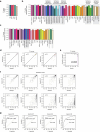Rapid epigenomic classification of acute leukemia
- PMID: 40983754
- PMCID: PMC12513838
- DOI: 10.1038/s41588-025-02321-z
Rapid epigenomic classification of acute leukemia
Abstract
Acute leukemia requires precise molecular classification and urgent treatment. However, standard-of-care diagnostic tests are time-intensive and do not capture the full spectrum of acute leukemia heterogeneity. Here, we developed a framework to classify acute leukemia using genome-wide DNA methylation profiling. We first assembled a comprehensive reference cohort (n = 2,540 samples) and defined 38 methylation classes. Methylation-based classification matched standard-pathology lineage classification in most cases and revealed heterogeneity in addition to that captured by genetic categories. Using this reference, we developed a neural network (MARLIN; methylation- and AI-guided rapid leukemia subtype inference) for acute leukemia classification from sparse DNA methylation profiles. In retrospective cohorts profiled by nanopore sequencing, high-confidence predictions were concordant with conventional diagnoses in 25 out of 26 cases. Real-time MARLIN classification in patients with suspected acute leukemia provided accurate predictions in five out of five cases, which were typically generated within 2 h of sample receipt. In summary, we present a framework for rapid acute leukemia classification that complements and enhances standard-of-care diagnostics.
© 2025. The Author(s).
Conflict of interest statement
Competing interests: C.S. discloses advisory honoraria from AbbVie, Astellas, AstraZeneca, BMS, Laboratories Delbert, Jazz Pharmaceuticals, Novartis, Otsuka, Pfizer and Roche, institutional research support from Jazz Pharmaceuticals and travel grants from AbbVie, BMS, Jazz Pharmaceuticals and Pfizer. E.C.C. discloses advisory honoraria from AbbVie, Merck, ImCheck, Rigel, Guidepoint, Trinity Health Sciences and GLG, and research support from AbbVie. G.K.G. receives research support from Calico Life Sciences. The other authors declare no competing interests.
Figures


















References
-
- Weinberg, O. K. et al. The International Consensus Classification of acute leukemias of ambiguous lineage. Blood141, 2275–2277 (2023). - PubMed
MeSH terms
LinkOut - more resources
Full Text Sources
Medical

